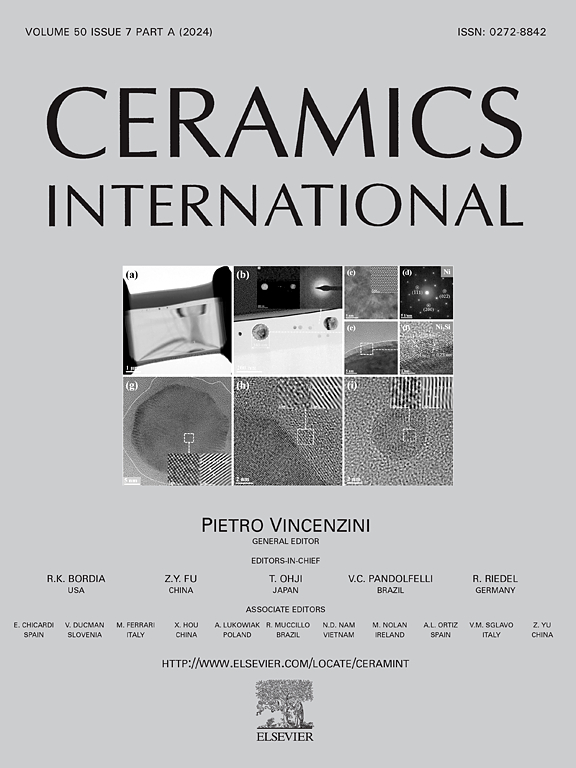高效宽带绿色发光Ca2LuScGaAlSi2O12:Ce3+石榴石荧光粉用于高显色全光谱WLED照明
IF 5.6
2区 材料科学
Q1 MATERIALS SCIENCE, CERAMICS
引用次数: 0
摘要
为了实现高性能的白光发光二极管(wled)照明,宽带绿色荧光粉仍然被认为是关键材料。在这项研究中,我们成功地合成了一系列高效的Ca2Lu1-xScGaAlSi2O12:xCe3+ (CLS:xCe3+)石榴石型荧光粉,具有宽带绿色发射(峰中心在525 nm;半最大全宽度,FWHM = 106 nm)。CLS:xCe3+绿色荧光粉由于其最佳激发波长为452nm,因此非常适合用于蓝色泵浦wled。系统地研究了CLS:xCe3+荧光粉的晶体结构、电子结构、能带结构、激活剂占用率和光致发光性能。最佳CLS:0.04Ce3+样品具有良好的热稳定性(57%@423 K),出色的颜色稳定性(ΔE = 3.50 × 10−3,423 K)和较高的内量子效率(IQE = 70%)。此外,通过将绿色荧光粉CLS:0.04Ce3+和商用红色荧光粉CaAlSiN3:Eu2+集成在450nm LED芯片上,高性能WLED原型可以发出高显色指数(CRI = 94)和相对较低的相关色温(CCT = 4508 K)的全光谱暖白光。结果表明,所报道的Ca2LuScGaAlSi2O12:Ce3+绿色石榴石荧光粉具有作为下一代高性能全光谱WLED照明绿色发光材料的巨大潜力。本文章由计算机程序翻译,如有差异,请以英文原文为准。
Efficient broadband green-emitting Ca2LuScGaAlSi2O12:Ce3+ garnet phosphor towards high-color-rendering full-spectrum WLED lighting
To achieve high-performance white light emitting diodes (WLEDs) lighting, broadband green phosphors are still considered key materials. In this study, we successfully synthesized a series of efficient Ca2Lu1-xScGaAlSi2O12:xCe3+ (CLS:xCe3+) garnet-type phosphors with broadband green emission (peak centered at 525 nm; full width at half maximum, FWHM = 106 nm). The CLS:xCe3+ green phosphors are well suited for use in blue-pumped WLEDs due to their optimal excitation wavelength of 452 nm. The crystal structure, electronic structure, band structure, activator occupancy and photoluminescence properties of the CLS:xCe3+ phosphors were systematically investigated. The optimal CLS:0.04Ce3+ sample exhibits good thermal stability (57%@423 K), outstanding color stability (ΔE = 3.50 × 10−3 at 423 K) and a high internal quantum efficiency (IQE = 70%). Moreover, by integrating the green phosphor CLS:0.04Ce3+ and commercial red phosphor CaAlSiN3:Eu2+ with a 450 nm LED chip, a high-performance prototypical WLED can emit full-spectrum warm white light with high color rendering index (CRI = 94) and relatively low correlated color temperature (CCT = 4508 K). The results indicate that the reported Ca2LuScGaAlSi2O12:Ce3+ green garnet phosphor exhibits significant potential as a next-generation green-emitting material for high-performance full-spectrum WLED lighting.
求助全文
通过发布文献求助,成功后即可免费获取论文全文。
去求助
来源期刊

Ceramics International
工程技术-材料科学:硅酸盐
CiteScore
9.40
自引率
15.40%
发文量
4558
审稿时长
25 days
期刊介绍:
Ceramics International covers the science of advanced ceramic materials. The journal encourages contributions that demonstrate how an understanding of the basic chemical and physical phenomena may direct materials design and stimulate ideas for new or improved processing techniques, in order to obtain materials with desired structural features and properties.
Ceramics International covers oxide and non-oxide ceramics, functional glasses, glass ceramics, amorphous inorganic non-metallic materials (and their combinations with metal and organic materials), in the form of particulates, dense or porous bodies, thin/thick films and laminated, graded and composite structures. Process related topics such as ceramic-ceramic joints or joining ceramics with dissimilar materials, as well as surface finishing and conditioning are also covered. Besides traditional processing techniques, manufacturing routes of interest include innovative procedures benefiting from externally applied stresses, electromagnetic fields and energetic beams, as well as top-down and self-assembly nanotechnology approaches. In addition, the journal welcomes submissions on bio-inspired and bio-enabled materials designs, experimentally validated multi scale modelling and simulation for materials design, and the use of the most advanced chemical and physical characterization techniques of structure, properties and behaviour.
Technologically relevant low-dimensional systems are a particular focus of Ceramics International. These include 0, 1 and 2-D nanomaterials (also covering CNTs, graphene and related materials, and diamond-like carbons), their nanocomposites, as well as nano-hybrids and hierarchical multifunctional nanostructures that might integrate molecular, biological and electronic components.
 求助内容:
求助内容: 应助结果提醒方式:
应助结果提醒方式:


